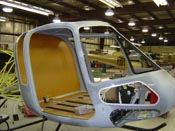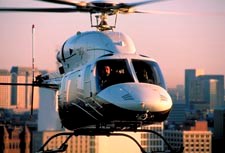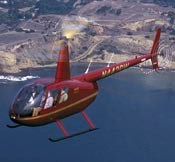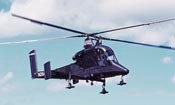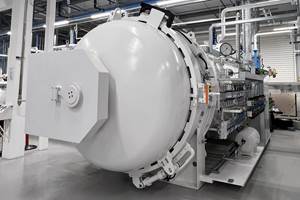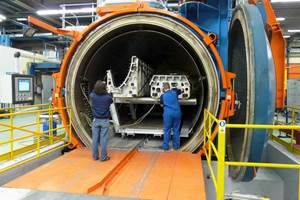Composites take off ... in some civil helicopters
Slowed by certification requirements, composites nevertheless are finding their way into the fuselages and rotor blades of commercial helicopters.
Helicopter manufacturers have long recognized the benefits of composites in critical aircraft components. In today's military rotorcraft, composites regularly constitute 50 to 80 percent -- or more -- of the airframe by weight. But in helicopters built for the civil aviation sector, composite application varies much more widely. Some manufacturers draw heavily on their experiences with military rotorcraft and make significant use of composites. Others employ composites only in specialized or nonstructural components or those for which metals are impractical and/or cost-prohibitive. In the following survey of major manufacturers, some variation can be attributed, in part, to differences in experience and manufacturing philosophy. However, several attribute their reluctance to expand composite use in rotorcraft to certification rules recently rewritten by the Federal Aviation Admin. (FAA), whose more stringent requirements for composites inflate costs and overtax the smaller R&D budgets available for some commercial applications.
Battle-proven, civilian-ready
Bell Helicopter Textron, which builds military rotorcraft, including the UH-1 Huey and the V-22 Osprey, has been one of the few companies able to parlay military experience into composites-intensive civil helicopters. For example, major composite components on the M427 Light Twin helicopter, the company's most recent commercial model (certified in 1998), include structural sidebody panels, floor panels, bulkheads, nose skins, shroud, doors, fairings, cowlings and stabilizers. In fact, composite materials in the M427 constitute some 80 percent of the airframe parts, both structural and nonstructural, reports Bruce Lunam, manufacturing R&D coordinator at Bell Helicopter Textron Canada Ltd. (Mirabel, Quebec, Canada). "These materials allow designers to reduce the number of parts the helicopter is made of, thus reducing manufacturing cost," he notes.
The M427's two sidebody panels illustrate this advantage. Each 1.5m by 5.5m (5-ft by 18-ft) panel replaces dozens of conventional multi-part sandwich panels made with skins, honeycomb core and stiffeners of aluminum. This large fuselage section also eliminates the need for hundreds of rivets. Each composite sidebody panel is hand layed up as a single piece from carbon/epoxy prepreg in either composite or metal tooling. The panels also incorporate phenolic resin-impregnated core material, according to Lunam, to ensure compatibility with the resin system. As with all composite components at Bell, the panels are vacuum-bagged and cured in an autoclave. Composite stiffeners are bonded to the inside of the sidebody panels in a secondary operation. Final weight of one sidebody panel is 27 kg/60 lb, extremely light for a panel with such large proportions.
Lunam cautions that unique requirements and design criteria make it difficult to characterize across-the-board advantages that composites bring to each helicopter component. While weight reduction may be a factor prompting a switch to composites, a toughened design, increased corrosion resistance, reductions in part count and manufacturing cost and/or manufacturability of complex shapes can be significant drivers as well. For components with complex contours, composites offer greater part-for-part consistency. "Repeatability," Lunam maintains, "is a considerable advantage compared to most sheet metal components that are subject to contour variations." For this reason, most of Bell's nose skins have been made from composites for decades, as have the fairings and cowlings. Bell improved the design and material selection for these components on the M427. The company designs the parts on a CAD system, then develops the laminate schedule on specialized software, which also provides flat patterns. Prepreg cutting is performed on an ultrasonic ply cutter. Nesting software ensures minimal scrap. Layup is aided with laser projection of ply patterns.
Structural applications of composites on Bell Helicopter's commercial M427 include the sidebody panels, floor panels, bulkheads and rotor blades; as well as the horizontal stabilizer, which is a primary flight-safety critical structure, Lunam reports. Composites replace conventional aluminum sandwich construction in each of these components. Likewise, the composite shroud (positioned behind the nose of the helicopter to protect instruments and wiring) replaces a combination of aluminum and thermoplastic materials used on conventional shroud designs. While doors on Bell's medium- and heavy-lift helicopters have used composites, the M427's composite doors represent only the second such composite application in light-duty helicopters.
Overall, about 80 percent of the M427's composite parts consist of carbon/epoxy. The remainder is made mostly from fiberglass/epoxy, although some parts requiring high temperature resistance, such as cowling and empennage parts, are carbon/bismaleimide with some glass/bismaleimide layers. Phenolic-impregnated core materials are incorporated in the vast majority of these components.
Certification slowdowns
Cases like Bell's M427 bode well for composites. Likewise, Sikorsky Aircraft Corp.'s most recent commercial helicopter, the S-92. A 19-passenger rotorcraft in civil-transport configuration, the S-92 borrows a great deal from Sikorsky's military helicopter experience -- evolving from the S-70 U.S. Army Black Hawk and the U.S. Navy Seahawk helicopters in particular -- and reportedly relies heavily on composite materials. Sikorsky (Stratford, Conn.) was unavailable to comment on the S-92 in the heat of its competition for the new Marine One U.S. Presidential fleet (the results of which are reported in this issue's "News"), but published reports make it clear that the company is using state-of-the-art composites fabrication techniques on this helicopter. The main rotor blade is composite, and the fuselage, which measures 17.1m long by 3.9m wide by 4.3m high (56.2 ft by 12.8 ft by 14.2 ft) combines metal and composite parts. Overall, the composites in the fuselage and rotor blades make up 30 percent of these structures. Laser projection technology from Assembly Guidance Systems (Chelmsford, Mass.), first used on Sikorsky's now-defunct RAH-66 Comanche helicopter (see HPC March 2004, p. 26), is expediting ply placement on S-92 composite parts. The first S-92 was delivered to a customer in September 2004. In addition to the civil-transport version, Sikorsky also offers the S-92 in a utility transport version, with 22 side-facing seats, as well as cargo and search-and-rescue versions.
According to Sikorsky, the S-92 is, thus far, the only helicopter in the world to meet the latest, most stringent FAA safety regulations, found in Federal Aviation Regulation (FAR) Part 29. But FAA certification, especially in light of new requirements for damage tolerance certification that were drafted in 2001, has limited composites development on some commercial helicopters to only incremental advances. Both FAR Part 29, which applies to helicopters in the FAA's "Transport" category (weight over 7000 lb and 10 or more passenger seats), and FAR Part 27, for the FAA's "Normal" category (weight under 7000 lb and nine or fewer passenger seats), will require manufacturers to demonstrate that any critical "structure, with flaws present, is able to withstand repeated loads of variable magnitude without detectable flaw growth" for the life of the rotorcraft or a specified part replacement time, as stated in the Part 29 draft.
"That means you have to include the effects of anticipated manufacturing flaws as well as service damage, dropped tools and so on during your qualification program," explains Barry Pickett, staff engineer for helicopter programs at Kaman Aerospace Corp. (Bloomfield, Conn.). "You can't assume a pristine structure." Previously, damage tolerance certification was recommended, not required, and only for the larger "Transport" category. Formal requirements for both categories are now winding through the FAA rulemaking process; promulgation is anticipated sometime this summer. "But I believe most people are working to the spirit of them already," Pickett notes.
The new rule increases certification costs more for composites than for metals, Pickett continues, because metal manufacturing flaws are more easily anticipated and analyzed. He agrees that programs like the DOT/FAA/AR-00/47 qualification plan, also known as the AGATE (Advanced General Aviation Technology Experiment) methodology, which generates design allowables for composite materials (see HPC, May 2003, p. 38), "should help especially small manufacturers, like ourselves, with small qualification budgets." But even companies like Sikorsky, which can take advantage of military technology, nevertheless face significant costs for FAA certification. "The FAA is a different animal; it's a different set of rules" than for military aircraft, says Pickett.
Out of the wood
Although Kaman's commercial helicopter, the K-MAX, was certified in 1994, before the latest FAA rules were drafted, the company selected metals, primarily aluminum, for the fuselage's structural components, using composites only in the rotor blades and some nonstructural parts. "You always have to think about market size and the investment in tooling for composites," explains George Schafer, K-MAX program manager. Called an "aerial truck" by the company, K-MAX was designed for external lift operations required in oil rig and pipeline construction, utility power pole erection, fire-fighting and timber harvesting. "When we started K-MAX development, the market size was unknown," Schafer says, but notes that, to date, the company has produced 38 K-MAX helicopters.
Unable to justify the investment in tooling required for composites, Kaman engineers also had a practical motivation for selecting metals. "The environment our customers work in is like the environment for bulldozers," Schafer contends. Field repairability was, therefore, a critical objective. As a result, the only fuselage components made from composites were those with critical contoured surfaces, the nose cone (fiberglass/epoxy) and the tip caps on the vertical stabilizers. These solid-laminate parts are fabricated by wet layup and cured at room temperature.
For the helicopter's 7.3m/24-ft long composite rotor blades, Kaman uses wood laminate spars, based on technology dating back to the 1950s. Pickett explains that the company selected wood for its damage tolerance and fatigue resistance and to take advantage of field experience and qualification data amassed from a similar spar on its HH-43 helicopter, built for the U.S. Air Force in the '50s and '60s. Layers of wood are glued together with penacolite adhesive and carved to aerodynamic contour on a 5-axis NC machine. To enhance the spar's stiffness, unidirectional IM7/8552 carbon/epoxy prepreg tape from Hexcel (Dublin, Calif.) is bonded to the spar with Henkel Corp. (Bay Point, Calif.) Hysol EA 9394 two-part epoxy. Finally, the spar is wrapped in a dry glass cloth, which is wet out with EPON 828 epoxy, from Resolution Performance Products LLC (Houston, Texas).
The blade "afterbody," Kaman's term for the portion of the blade aft of the spar, is composed of woven 7781 and 120 glass/epoxy prepreg, supplied by J.D. Lincoln Inc. (Costa Mesa, Calif.), over Hexcel Nomex honeycomb core. Unidirectional carbon/epoxy also is added to the trailing edge spline to provide edgewise bending stiffness. The afterbody skins are fabricated via hand layup from prepreg ply patterns cut on automated equipment from Gerber Technology Inc. (Tolland, Conn.). The skins are bonded to the core with Sovereign Specialty Chemicals (Buffalo, N.Y.) Plastilock 717 adhesive and the assembly is autoclave-cured at 121?C/250?F and 103 kPa/15 psi. The afterbody and spar are assembled and bonded with Hysol EA 9394, which is cured at 66?C/150?F.
Each rotor blade has an aerodynamic control surface called a servo flap, a feature unique to Kaman. This 91-cm/36-inch long flap is attached along the blade's trailing edge at two locations and is centered at about 70 percent of the blade span. "That FAR aft of the blade pitch axis, it has to be light," Schafer says. The servo flap is hand layed up from Hexcel woven carbon/epoxy prepreg and cocured in a single operation using a heated matched mold tool at 177?C/350?F.
Away from the curve
The new FAR rules affecting fuselage and rotor materials have had little impact on Robinson Helicopter Co. (Torrance, Calif.), which leads world production of civil helicopters with 5,400 helicopters built through 2004. The company has been well served by the principle of "keeping everything simple for our high production volumes," notes Kurt Robinson, VP of product support. While Robinson Helicopter has advanced many of its technologies, most recently in 2002 with the addition of a fuel-injected engine in its R44 Raven II model, it has kept the fuselage and rotor materials the same since its first helicopter flew in 1975.
Composites are used only in the doors, air inlet, roof, and the "chin" and aft cowling back plate. Glass/polyester solid laminates (and some glass with high-temperature epoxy for areas near the engine) are built for Robinson by an outside vendor via wet layup and an oven cure. Composites provide strength and light weight at a low cost for these nonstructural components, Robinson reports, especially for the components that exhibit some curvature. "But we shy away from complex curves in the aircraft just because of costs," he notes. Seats and structural cabin components are all aluminum. Aluminum braces provide the structure to which the composite components are riveted. The rotor blades are stainless steel with honeycomb core and a stainless steel spar.
Into the black?
A helicopter manufacturer since the 1960s, Enstrom Helicopter Corp. (Menominee, Mich.) has made incremental changes to its fuselage over the years, and more change may be in the air. "I'm sure we're going to be using composites more," reports Bill Taylor, director of engineering. "We're looking into epoxies versus polyester, and even carbon fiber." In fact, the company investigated new materials more than 15 years ago, for its 480B turbine-engine model, certified in 1991. The fuselage for the 480B is larger, to seat five compared to Enstrom's three-seat piston-engine models. Besides the size increase, however, most of the airframe components are essentially the same construction that Enstrom has been using for 40-plus years.
Rotor blades for all Enstrom helicopters are hollow aluminum with stainless steel abrasion strips, "a very rugged blade that works well for us," says Taylor. Also made from aluminum are the craft's tail cone and cowling, whose single-axis curves can be formed easily with metals. The largest composite component, the cabin shell, consists of a glass/polyester solid laminate. The cabin's compound curves (curves with more than one-axis) are much easier to produce from composites than metals, Taylor notes, but components without compound curvature are still considered an easier build with standard metal aircraft technology. The cabin shell is made using wet layup and room-temperature cure of standard-weave roving and polyester from Composites One (Arlington Heights, Ill.) on female molds also constructed of glass/polyester -- as it has been almost since Enstrom's first helicopter. The cabin shell uses Ferro Corp. (Vista, Calif.) gel coat. In the 480B, the company considered upgrading to aramid reinforcement, "but the weight savings did not justify the cost, and glass was stiffer anyway," Taylor contends.
Aramid construction did prove viable for the 480B's cabin back wall and floor, as well as the structure around the fuel tanks. Enstrom is using a Hexcel panel of aramid/epoxy skins and Nomex honeycomb core for these components. The aramid/epoxy enhances fire protection, compared to the aluminum panel and frames used on the company's other models, says Taylor. The panels are cut to the desired shapes, sealed with Henkel Hysol adhesive, and both adhesively bonded and mechanically fastened into the fuselage assembly. The Hysol adhesive provides bonding redundancy while acting as a sealant, Taylor reports.
Taylor explains the motivation to introduce more composites in the future: "Vehicle weight is extremely important, especially in aircraft the size of ours. The smaller and lighter the aircraft, the smaller and lighter all the components can be, and the less power the engine must provide. But," he cautions, "we have to balance that with cost." Having built 23 helicopters in 2004 and anticipating a total of 32 in 2005, Enstrom is in a period of growth; nevertheless, limited funds for research and development, as well as FAA certification costs, keep the company's advancements very measured.
In the near term, Taylor predicts only a slight increase in the number of components made from composites on Enstrom helicopters, but significant advances in material type for existing composite components. The doors seem to be a natural candidate for a starting point, he adds. Currently made from fiberglass/polyester, the doors could clearly benefit from the greater specific stiffness that a carbon composite offers. "If we start with the doors and learn how to handle carbon composites, we can then start looking at larger components," he explains. "We will continue looking at both strength and stiffness objectives while keeping a good level of manufacturability with our techniques."
Related Content
Plant tour: Spirit AeroSystems, Belfast, Northern Ireland, U.K.
Purpose-built facility employs resin transfer infusion (RTI) and assembly technology to manufacture today’s composite A220 wings, and prepares for future new programs and production ramp-ups.
Read MoreBusch expands autoclave solutions
Busch announces its ability to address all autoclave, oven and associated composites manufacturing requirements following the acquisition of Vacuum Furnace Engineering.
Read MorePlant tour: Airbus, Illescas, Spain
Airbus’ Illescas facility, featuring highly automated composites processes for the A350 lower wing cover and one-piece Section 19 fuselage barrels, works toward production ramp-ups and next-generation aircraft.
Read MorePlataine unveils AI-based autoclave scheduling optimization tool
The Autoclave Scheduler is designed to increase autoclave throughput, save operational costs and energy, and contribute to sustainable composite manufacturing.
Read MoreRead Next
All-recycled, needle-punched nonwoven CFRP slashes carbon footprint of Formula 2 seat
Dallara and Tenowo collaborate to produce a race-ready Formula 2 seat using recycled carbon fiber, reducing CO2 emissions by 97.5% compared to virgin materials.
Read More“Structured air” TPS safeguards composite structures
Powered by an 85% air/15% pure polyimide aerogel, Blueshift’s novel material system protects structures during transient thermal events from -200°C to beyond 2400°C for rockets, battery boxes and more.
Read MorePlant tour: Daher Shap’in TechCenter and composites production plant, Saint-Aignan-de-Grandlieu, France
Co-located R&D and production advance OOA thermosets, thermoplastics, welding, recycling and digital technologies for faster processing and certification of lighter, more sustainable composites.
Read More



